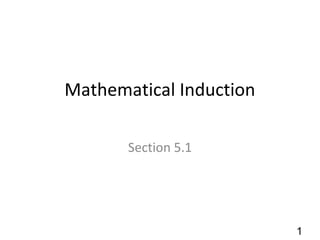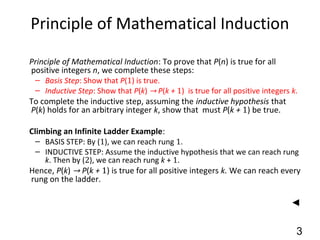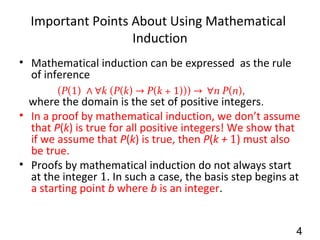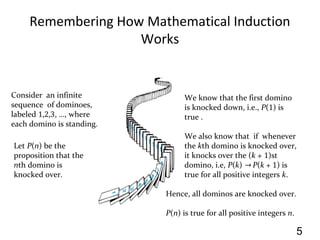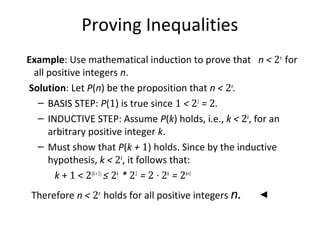5.1 Induction
- 2. Climbing an Infinite Ladder 2 Suppose we have an infinite ladder: 1. We can reach the first rung of the ladder. 2. If we can reach a particular rung of the ladder, then we can reach the next rung. From (1), we can reach the first rung. Then by applying (2), we can reach the second rung. Applying (2) again, the third rung. And so on. We can apply (2) any number of times to reach any particular rung, no matter how high up. This example motivates proof by mathematical induction.
- 3. Principle of Mathematical Induction Principle of Mathematical Induction: To prove that P(n) is true for all positive integers n, we complete these steps: â Basis Step: Show that P(1) is true. â Inductive Step: Show that P(k) â P(k + 1) is true for all positive integers k. To complete the inductive step, assuming the inductive hypothesis that P(k) holds for an arbitrary integer k, show that must P(k + 1) be true. Climbing an Infinite Ladder Example: â BASIS STEP: By (1), we can reach rung 1. â INDUCTIVE STEP: Assume the inductive hypothesis that we can reach rung k. Then by (2), we can reach rung k + 1. Hence, P(k) â P(k + 1) is true for all positive integers k. We can reach every rung on the ladder. 3
- 4. Important Points About Using Mathematical Induction âĒ Mathematical induction can be expressed as the rule of inference where the domain is the set of positive integers. âĒ In a proof by mathematical induction, we donât assume that P(k) is true for all positive integers! We show that if we assume that P(k) is true, then P(k + 1) must also be true. âĒ Proofs by mathematical induction do not always start at the integer 1. In such a case, the basis step begins at a starting point b where b is an integer. 4 (P(1) ⧠âk (P(k) â P(k + 1))) â ân P(n),
- 5. Remembering How Mathematical Induction Works 5 Consider an infinite sequence of dominoes, labeled 1,2,3, âĶ, where each domino is standing. We know that the first domino is knocked down, i.e., P(1) is true . We also know that if whenever the kth domino is knocked over, it knocks over the (k + 1)st domino, i.e, P(k) â P(k + 1) is true for all positive integers k. Let P(n) be the proposition that the nth domino is knocked over. Hence, all dominos are knocked over. P(n) is true for all positive integers n.
- 6. Proving a Summation Formula by Mathematical Induction Example: Show that: Solution: â BASIS STEP: P(1) is true since 1(1 + 1)/2 = 1. â INDUCTIVE STEP: Assume true for P(k). The inductive hypothesis is Under this assumption, 6 Note: Once we have this conjecture, mathematical induction can be used to prove it correct.
- 7. Proving Inequalities Example: Use mathematical induction to prove that n < 2n for all positive integers n. Solution: Let P(n) be the proposition that n < 2n . â BASIS STEP: P(1) is true since 1 < 21 = 2. â INDUCTIVE STEP: Assume P(k) holds, i.e., k < 2k , for an arbitrary positive integer k. â Must show that P(k + 1) holds. Since by the inductive hypothesis, k < 2k , it follows that: k + 1 < 2(k+1) âĪ 2k * 21 = 2 â 2k = 2k+1 Therefore n < 2n holds for all positive integers n.
- 8. 8
